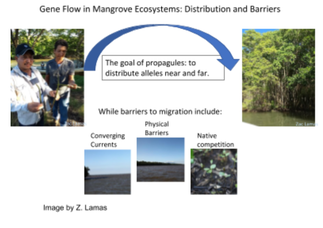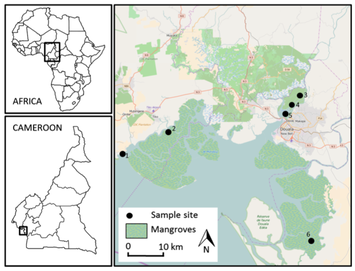|
Written by: Maggie Hartman, Zac Lamas, Arielle Arsenault-Benoit If you have been to the coastal tropics or subtropics, you may have seen lush trees, with almost science fiction-like root systems. These are trees in the genus Rhizophora, colloquially known as the mangroves. Mangrove forest ecosystems are coastal and found between 30° N and 30° S. They are a flowering angiosperm, with a hydrochorous propagule dispersal mechanism (dispersal occurs via water). The propagules are seedlings, formed by the embryo growing through the seed coat and fruit wall, while still attached on the mother tree, a phenomenon known as vivipary.. These propagules depend on the ocean surface current to disperse both close by and remotely; they are capable of floating in ocean currents for up to three months or more. Alternatively, mangrove gene dispersal can occur via pollen transfer by wind or insects. Ideally, these propagules are distributed to new environments where they can sprout, and mature into an adult tree. If the new tree is capable of maturing and reproducing in a new area, we would cite this as an example of gene flow. If you’re having a hard time imagining this, just think of the cosmopolitan coconut. Although technically the coconut is a drupe and not a propagule, their distribution in ocean currents is synonymous. Unfortunately for our hopeful mangroves, their propagules have to overcome barriers that restrict their distribution.  Dr. Magdalene Ngeve, a postdoctoral researcher in Dr. Maile Neel’s lab, used one of the most important plants in her native country of Cameroon, the mangrove species Rhizophora racemosa, to better understand population genetic structuring. Rhizophora racemosa propagules are long and slender and have the potential to travel far distances before planting because of long viability and flotation periods. Rhizophora racemosa makes up about 90% of the mangrove cover in Cameroon and is prized by locals both socio-economically and ecologically. In a world where human pressure is relentless, understanding population genetic structure is vital. Dr. Ngeve investigated several questions regarding historical and contemporary (barriers and/or drivers of) gene flow of Rhizophora spp. Here we will look at how geographical formations, converging ocean currents, and native competition can either promote gene flow or act as a barrier to gene flow. First, they looked at current literature to form assumptions of how the Cameroon Volcanic Line and converging currents in the Cameroon Estuary may impede dispersal of propagules. Her team then collected Rhizophora racemosa samples in their study site. Finally, they used virtual propagules dispersal modeling in conjunction with genetic data to test the effect of these barriers on actual dispersal. In nature, the ability to disperse genetic material over a landscape is important whether you are a highly mobile animal or a plant firmly rooted in the ground. This gene dispersal is necessary to the survival of a species not only as a whole but in each of the geographical areas it may inhabit worldwide. A propagule dispersed by ocean currents for months from one mangrove system before making its way to another estuary is just part of the journey. Upon stranding, it still has to sprout and grow. It may unluckily land on a rocky surface. Even crueler, this emigrating propagule has to compete with all native propagules in the new estuary. These native sprouts may be better locally adaptive. It is important to keep in mind dispersal is just one part of successful gene flow. And here is where a very important part of Dr. Ngeve’s research comes in: Numbers matter! Ocean currents and geomorphological formations can promote or inhibit gene flow. She found in their Cameroon Estuary that converging ocean currents did not increase genetic diversity (Ngeve, 2017). In fact, these convergence zones act as a barrier, and that propagules from both sides cannot cross (Ngeve, 2016). Additionally, distance alone was a barrier to gene flow. Dr. Ngeve assessed that even when accounting for the dual variables of distance or converging ocean currents, both variables independently of each other restrict gene flow. The big surprise was that the Cameroon Volcanic Line (CVL) was not a significant barrier to gene flow, and that dispersal between two estuaries separated by the CVL during glacial times was high, due to corridors formed by rising sea levels. Dr. Ngeve wanted to test the hypotheses that gene flow is unidirectional from upstream to downstream on the Wouri River in the Cameroon Estuary complex (CEC) and that each catchment has a unique gene pool (Fig. 1), on a local scale (100km). She sampled mangrove leaf tissue from the CEC and analyzed the DNA for genetic diversity among catchments. They also used a capture-release experiment to test the dispersal of propagules through the linear mangrove ecosystem of this river. The mangrove population in this estuary is under high anthropogenic pressure, as local residents remove sand and lumber, so it is a likely candidate for restoration and conservation. To observe how mangroves are distributed on a local scale, propagules were marked and released into the river at four sites; then the area was surveyed for their final location. Dr. Ngeve found that dispersal was bi-directional-- propagules were dispersed both upriver due to the tides and downriver due to the river current. Along this tidal river, mangroves have strong genetic connectivity, yet, there is still isolation of the further-reaching populations that increases with distance. From these discoveries, conservation efforts can be targeted at maintaining genetic variability in order to foster resilient mangroves that can deal with the effects of climate change.  Figure 1. Six sites surveyed in or near the Cameroon Estuary complex (CEC). 1. Mabeta (North of CEC), 2. Tiko (North of CEC), 3. Upstream Wouri Channel (CEC), 4. Midway Wouri Channel (CEC), 5. Downstream Wouri Channel (CEC), 6. Mouanko Reserve (South of CEC) (Ngeve et al., 2017). Figure 1. Six sites surveyed in or near the Cameroon Estuary complex (CEC). 1. Mabeta (North of CEC), 2. Tiko (North of CEC), 3. Upstream Wouri Channel (CEC), 4. Midway Wouri Channel (CEC), 5. Downstream Wouri Channel (CEC), 6. Mouanko Reserve (South of CEC) (Ngeve et al., 2017). Dr. Ngeve and her colleagues studied mangrove genetic connectivity on a fine scale (~1km) in a highly disturbed estuary that experiences significant bottlenecks. Because propagules live on the mother tree for some time before abscission and subsequent dispersal, genetic information from the mother and propagule can be used to infer genetic information about the pollen source. Through a statistical method (“Twogener”) that compares genetic similarity of maternal trees and its offsprings, within a geographic distance, they discovered limit pollen dispersal within this estuary. Self-pollination was evident, as was moderate out-crossing. On average, three sires pollinated each mother tree. Pollen dispersal was restricted in all studied plots, especially on the leeward side of the estuary, where trees are sheltered from the wind and rely primarily on insect pollination. Biparental inbreeding (mating between closely related individuals) was highest in this area, suggesting that for this species, those on leeward areas rely more on insect than wind pollen dispersal. We hope this gave you a quick insight into the intriguing world of mangrove propagules, the quest for genetic dispersal, and the worldly barriers in between! Taken together, these studies demonstrate that pollen and propagule dispersal are the crux of mangrove genetic connectivity and diversity, which relates directly to conservation and restoration in the estuarine ecosystem. This work also shows that multiple factors impact genetic connectivity at each scale, and it is imperative to integrate our understanding across multiple scales to appreciate the full picture. Dr. Ngeve’s research has important conservation implications not only for mangroves. She has been awarded the President’s Postdoctoral Fellowship and will continue her work in Dr. Neel’s lab at the University of Maryland. Magdalene’s father actually completed his education at the University of Maryland, so coming here felt like “coming home.” Welcome, Magdalene! References: Frankham, R. (1996). Relationship of genetic variation to population size in wildlife. Conservation Biology, 10: 1500–1508. Ngeve, M.N., Stocken, T.V., Menemenlis, D., Koedam, N, & Triest, L. (2016). Contrasting Effects of Historical Sea Level Rise and Contemporary Ocean Currents on Regional Gene Flow of Rhizophora racemosa in Eastern Atlantic Mangroves. Plos One, https://doi.org/10.1371/journal.pone.0150950 Ngeve, M.N., Stocken, T.V., Sierens, T., Koedam, N., & Triest, L. (2017). Bidirectional gene flow on a mangrove river landscape and between-catchment dispersal of Rhizophora racemosa (Rhizophoraceae). Hydrobiologia, 790, 93-108. Ngeve, M.N., Stocken, T.V., Menemenlis, D., Koedam, N, & Triest, L. (2017). Hidden founders? Strong bottlenecks and fine-scale genetic structure in mangrove populations of the Cameroon Estuary complex. Hydrobiologia, 803: 189-207. Comments are closed.
|
Categories
All
Archives
June 2024
|
Department of Entomology
University of Maryland
4112 Plant Sciences Building
College Park, MD 20742-4454
USA
Telephone: 301.405.3911
Fax: 301.314.9290
University of Maryland
4112 Plant Sciences Building
College Park, MD 20742-4454
USA
Telephone: 301.405.3911
Fax: 301.314.9290

 RSS Feed
RSS Feed




